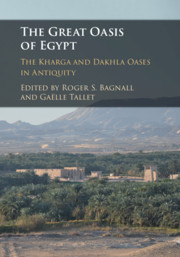Book contents
- The Great Oasis of Egypt
- The Great Oasis of Egypt
- Copyright page
- Contents
- Figures
- Tables
- Contributors
- Preface
- 1 Introduction
- Part I Living in the Oasis: Humans and the Environment
- Part II Managing the Oasis
- Part III Trade and Mobility in a Connected Environment
- Part IV An Oasis Culture?
- 13 Temple Building on the Egyptian Margins: The Geopolitical Issues behind Seti II and Ramesses IX’s Activity at Amheida
- 14 Funerary Practices in the Great Oasis during Antiquity
- 15 Was There an Interest in Literary Culture in the Great Oasis? Some Answers
- 16 The House of Serenos and Wall Painting in the Western Oases
- Bibliography
- Index of ancient people
- Index of places
- General index
13 - Temple Building on the Egyptian Margins: The Geopolitical Issues behind Seti II and Ramesses IX’s Activity at Amheida
from Part IV - An Oasis Culture?
Published online by Cambridge University Press: 12 July 2019
- The Great Oasis of Egypt
- The Great Oasis of Egypt
- Copyright page
- Contents
- Figures
- Tables
- Contributors
- Preface
- 1 Introduction
- Part I Living in the Oasis: Humans and the Environment
- Part II Managing the Oasis
- Part III Trade and Mobility in a Connected Environment
- Part IV An Oasis Culture?
- 13 Temple Building on the Egyptian Margins: The Geopolitical Issues behind Seti II and Ramesses IX’s Activity at Amheida
- 14 Funerary Practices in the Great Oasis during Antiquity
- 15 Was There an Interest in Literary Culture in the Great Oasis? Some Answers
- 16 The House of Serenos and Wall Painting in the Western Oases
- Bibliography
- Index of ancient people
- Index of places
- General index
Summary
The history of temple buildings in the Great Oasis shows periods of intense activity alternating with periods of relative quiet. When seen in combination with the varying amounts of archaeological remains over time, this data allows us to chart the development of contacts between the oases and the Nile Valley. In particular, this has consequences for the times of the Libyan conflicts of the 19th Dynasty. This chapter argues that the oases were in Libyan hands during this time, after which the Egyptian army re-established control. Two dated finds from the temple at Amheida, Dakhla, are of particular interest for this discussion. A stela of Seti II marks building works at Amheida shortly after the wars of Merenptah, and a fragment of relief dated to Ramesses IX sheds light on the incursions of Libyans into the Nile Valley at that time.
- Type
- Chapter
- Information
- The Great Oasis of EgyptThe Kharga and Dakhla Oases in Antiquity, pp. 221 - 236Publisher: Cambridge University PressPrint publication year: 2019

